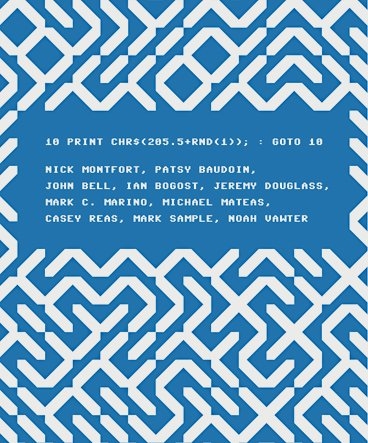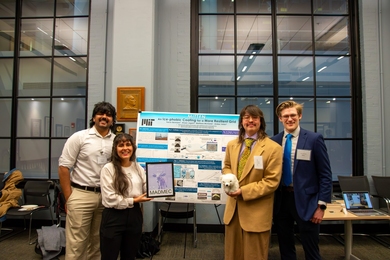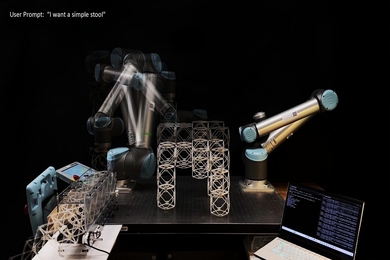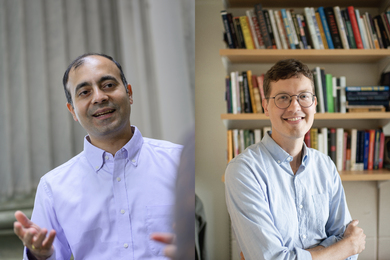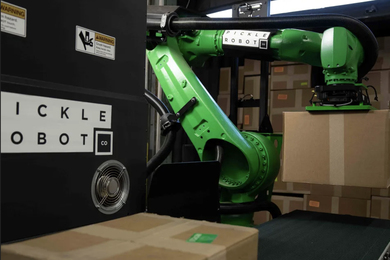A book co-written by an MIT professor takes a single line of code — the concise BASIC program for the Commodore 64, which also serves as the book's title — and uses it as a lens to examine both the phenomenon of creative computing and computer programs in culture.
The book’s title, “10 PRINT CHR$(205.5+RND(1)); : GOTO 10” (MIT Press, 2012), does not exactly roll off the tongue. But as computer code, it has the quality of concrete poetry in the eyes of Nick Montfort, associate professor of digital media in MIT's Comparative Media Studies/Writing program and the book’s lead author.
Written for the Commodore 64, one of the earliest personal computers (released in 1982), the phrase “10 PRINT CHR$(205.5+RND(1)); : GOTO 10” is a line of code in BASIC, the first widely popular programming language designed for use by non-scientists. When executed, the code randomly, and repeatedly, generates either a / or a \, filling the screen with a pattern that resembles a maze.
“The emergent complexity from this deceptively simple work is part of its interest,” says Montfort, noting that while not all code can be considered poetic, 10 PRINT is special. “I believe it is a concrete poem, a found poem. It’s a cultural artifact.”
Montfort identifies computer code in general as a culturally significant human language, just as deserving of close critical analysis as other products of culture. “No one would be startled to ask why a particular word is used in a literary text,” Montfort says. “Why can’t we do that with a line of code?”
Language that executes
Despite the title, “10 PRINT” is not a technical book of interest solely to programmers. Instead, the code is used as a jumping off point for examining a wide range of humanities questions, including the role the code’s maze plays in Western culture, and randomness in computing and the arts.
The authors even plumbed the depths of the code by examining it in translation, meaning to try it out in other programming languages (a process called porting). They discovered, for example, that in some languages the characters from different lines don’t touch each other, and so no maze is formed. “This allows us to see why this is a particularly pleasing program on the Commodore,” Montfort says.
Going to such lengths as to examine one small piece of code is a valuable exercise, Montfort says, because “code is a language that executes. It can have various kinds of significance, from artistic to economic to political."
He points out that the content of code has already made headlines, such as when the source code for Diebold voting machines was leaked in 2003, and when hackers unveiled code from Climatic Research Unit at the University of East Anglia in the United Kingdom, fueling reports that anthropogenic climate change was a hoax.
“We’re arguing that code is culturally significant — and that larger scale models of scholarship can be brought to bear on [fundamental] questions,” Montfort says.
This work is central to the new wave of research called “digital humanities,” he adds. “The intersection of digital and humanities is not just in new modes of presenting scholarship, it’s not just in ways computer techniques can be used to study materials — it’s also in understanding the ways computation and digital media have been transforming the culture."
‘Massively co-authored scholarship’
“10 PRINT” (the book) emerged from an online workshop organized by the Critical Code Studies Group, a collaborative conference focused on applying critical theory and hermeneutics (the study of the interpretation of written texts) to the interpretation of computer source code. Invited to contribute code for discussion, Montfort submitted the one-line 10 PRINT code, which he remembered from his childhood.
His post sparked a lively discussion among a wide range of experts — in art, writing, digital media, computer science and even library science. Montfort, who previously co-authored “Racing the Beam: The Atari Video Computer System” (MIT Press, 2009), quickly recognized the potential for a book on the topic.
He then tapped key contributors to join him in what he calls a “massively co-authored scholarship.” In total, “10 PRINT” has 10 authors, including Montfort and Patsy Baudoin, MIT Libraries liaison to the MIT Media Lab. Additional authors include John Bell; Ian Bogost; Jeremy Douglass; Mark C. Marino; Michael Mateas; Casey Reas SM ’01; Mark Sample; and Noah Vawter SM ’06, PhD ’11.
Even so, the book is not a collection of essays by 10 different people, but one coherent narration, told in one voice. “We had a wiki and wrote it together. Certain people would be lead writers for certain chapters, and there was an internal review process,” Montfort says. “It was a very complex process.”
Story prepared by MIT SHASS Communications
Editorial and Design Director: Emily Hiestand
Senior Writer: Kathryn O'Neill
